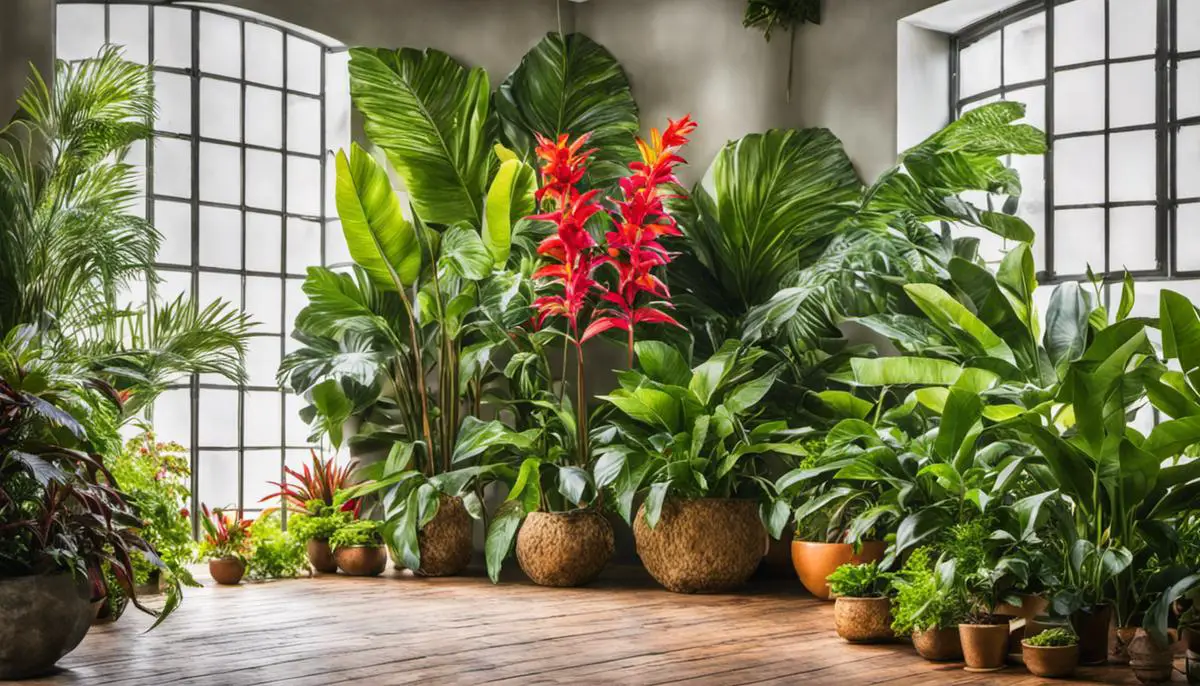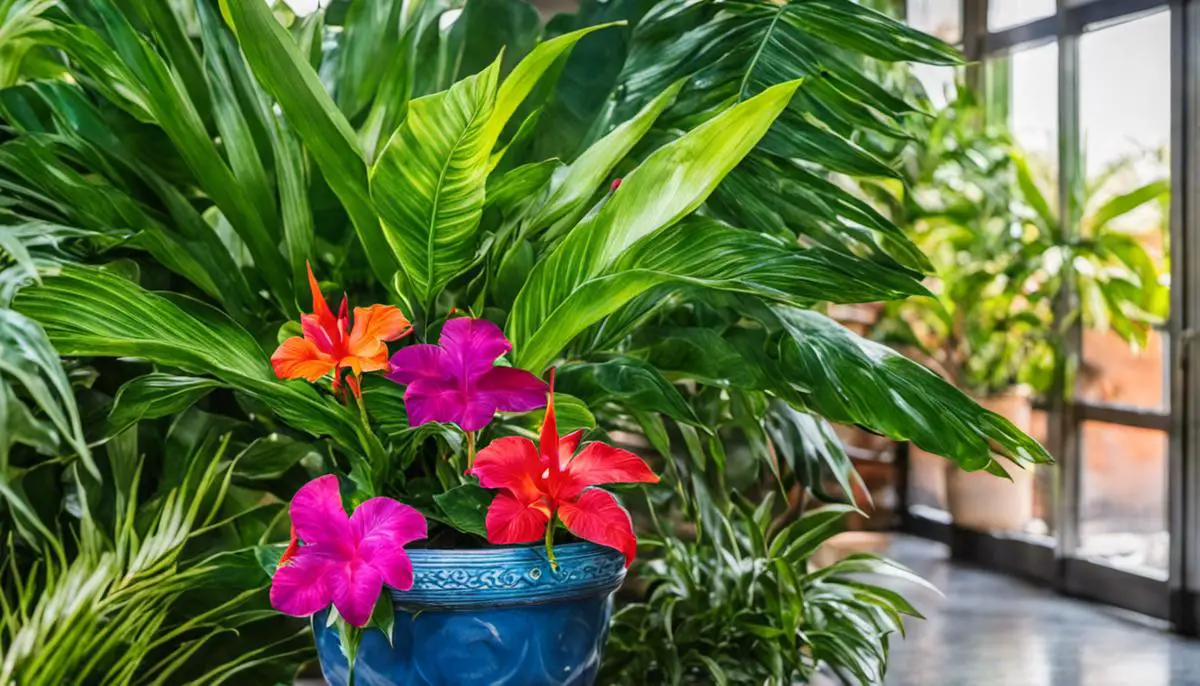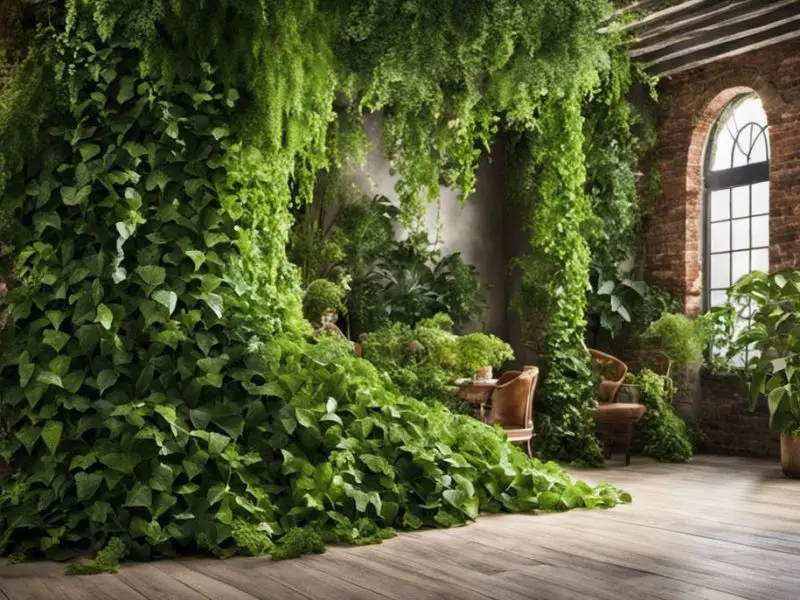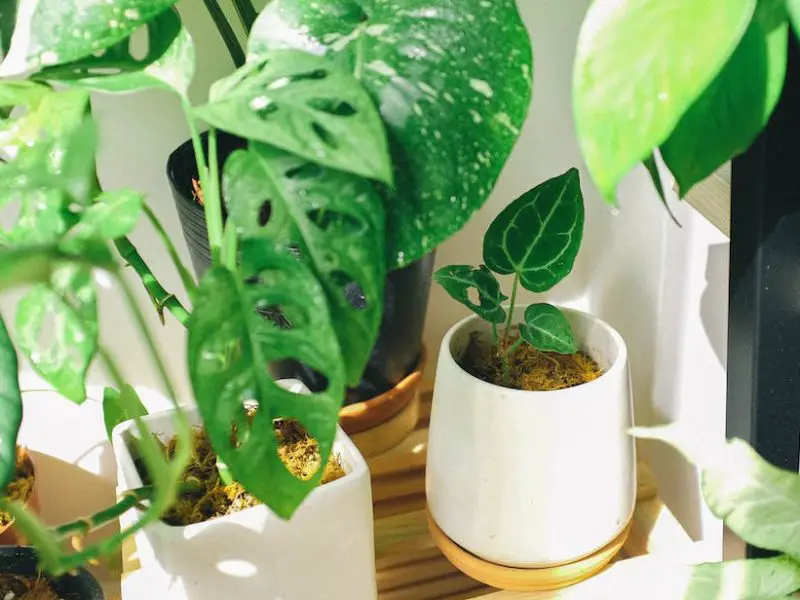Imagine the vibrant colors and exquisite beauty of the tropics gracing your indoor space. That’s the delightful possibility of cultivating tropical plants within the comfortable confines of your home or office. This venture requires more than just passion; it demands a deep understanding of each plant’s unique needs and the correct indoor conditions to achieve optimal growth. Our discussion dives right into selecting the right tropical plants for indoor cultivation, considering essential factors such as light, temperature, humidity, and maintenance needs. We also probe into the specifics of potting and repotting these exotic beauties, shedding light on the appropriate soil composition and handling procedures. Furthermore, you’ll discover how to provide the most conducive indoor environment for your tropical plants by regulating water, light, temperature, and humidity, along with discerning common plant problems and their timely resolutions.
Choosing the Right Tropical Plants
Understanding Light Requirements of Tropical Plants
Every plant species has a distinct preference for sunlight exposure, including tropical plants. These preferences can generally be grouped into three categories: low, medium, and high light requirements. Succulent tropical varieties such as Agave or Jade plants have high light needs and, therefore, should be established near windows or sources of abundant sunlight. Medium light plants such as Anthurium or Bromeliads thrive with indirect sunlight. Ferns and other tropicals adapted to forest undergrowth conditions, like the Peace Lily, are perfect examples of tropicals with low-light requirements.
Establishing Ideal Humidity and Temperature Levels
Tropical plants originated from warm regions characterized by high humidity. Consequently, most prefer daytime temperatures averaging between 70 to 80 degrees Fahrenheit and 55 to 60 degrees at night. Humidity levels should ideally be kept above 40 percent. To achieve this in indoor settings, consider incorporating pebble trays filled with water, regularly misting leaves, or utilizing home humidifiers.
Assessing Maintenance Levels
Maintenance levels vary widely among the variety of tropical plants. Some require rigorous care and attention, while others are relatively low-maintenance. Palms, Bromeliads, Snake Plants, and Philodendrons are suitable for beginners because they are easy to care for and require less maintenance. On the other hand, tropical plants like Orchids and Calatheas, while stunningly beautiful, demand high maintenance and a significant commitment to thrive.
Learning Plant Traits and Characteristics
Every tropical plant possesses unique traits and characteristics. Some plants like the Rubber Tree or Monstera can grow tall, making them suitable stand-alone statement pieces in a room. Plants like the Peace Lily or Philodendron are renowned for their air-purifying properties. Certain tropicals like the Venus Flytrap or the Pitcher Plant have carnivorous inclinations. Understanding these traits helps in making better placement decisions and leveraging the plant’s benefits optimally.
Limitations and Challenges with Tropical Plants
While tropical plants can bring lots of charm and breaths of fresh air into interior settings, they may also come with some challenges. Indeed, some tropical plants are notorious for attracting pest problems. Spider mites, scale insects, and whitefly are some examples. Additionally, tropical plants require consistent care, failing which, they may rapidly deteriorate. Lastly, plants like Sago Palm or Dieffenbachia can be toxic to pets, so their placement must be thoughtfully considered.
Benefits of Choosing Tropical Plants
Tropical plants offer several advantages. Many are renowned for their air-purifying qualities, enhancing interior air quality by filtering out common pollutants. Tropical plants can also significantly beautify indoor spaces, creating a calming and rejuvenating environment while boosting mood and productivity. Additionally, cultivating tropical plants can be a rewarding and therapeutic hobby.
For enthusiasts or hobbyists seeking to cultivate tropical plants in indoor containers, understanding the specific requirements, benefits, and potential restrictions of these plants is key. Such insights not only foster healthy plants but also enable informed and effective decision-making, perfectly aligning with personal preferences, the caregiver’s lifestyle, and the prevailing indoor living conditions.

Potting and Repotting Tropical Plants
Getting to Grips with Potting and Repotting Tropical Plants
The proper potting and timely repotting of tropical plants are two crucial components in nurturing your indoor greenery. The initial potting stage lays the groundwork for your tropical plant’s health and vitality. This process involves the meticulous positioning of a young or new plant into the right container, filled with nutrient-rich potting soil.
Remember, the container size matters during the initial potting. It must offer enough room for the plant’s root system, yet not be so large that it obstructs efficient water drainage – too much water is a fast track to root rot. It is also recommended to use a pot with drainage holes to prevent water accumulation at the bottom.
Repotting, conversely, is the act of moving mature or grown-out plants to a larger container, more suited to their expanded root network. Typically, the optimal repotting period for tropical plants is their growth season, which falls in the spring or early summer months. This method comprises unhurriedly removing the plant from its existing pot while causing minimal root disruption, then transferring it to a more spacious container with fresh potting soil.
The Importance of the Right Soil Composition
The quality and type of soil can significantly influence the growth and overall health of tropical plants. Thus, it’s fundamental to create the proper soil composition for tropical plants as they prefer well-draining soil rich in organic matter.
A standard mix for most tropical plants consists of equal parts potting soil, peat moss, and perlite. Potting soil provides essential nutrients, peat moss improves moisture retention while perlite aids in drainage, preventing waterlogged roots. Depending on the specific needs of a particular tropical plant, sand or bark chips can be added to create a more porous blend.
Handling Roots and Stems Carefully
When dealing with tropical plants, it’s vital to handle roots and stems with utmost care to prevent injury, leading to plant stress or disease. When repotting, be sure to gently loosen the root ball to promote better water absorption and facilitate adaptation to the new pot. However, refrain from tearing apart the roots as this could harm the plant.
Similarly, care should be taken when handling stems. Avoid any form of rough handling that can break the stem or cause injury. If a stem is accidentally broken during the repotting process, it should be cleanly cut off to prevent disease spread.
By thoroughly learning and applying the principles of potting and repotting, you can ensure your indoor tropical plants thrive successfully.

Providing Optimal Indoor Care
Getting to Know Tropical Plants
Originally hailing from warm and vibrant tropical climates, tropical plants are known for their variety in color, size, and form. Their unique aesthetics make them a go-to choice for indoor garden enthusiasts. However, adequately taking care of these plants in an indoor environment demands a solid understanding of their specific needs for water, light, temperature, and humidity — all factors inspired by their natural tropical habitats.
Effective watering habits for tropical plants
Watering requirements for tropical plants vary widely based on their species. Generally, these plants prefer a humid environment, mirroring their natural tropical ecosystem. However, overwatering can lead to root rot and various diseases. Therefore, a cautious watering routine is essential. Key indicators of a plant’s water needs include the condition of its leaves and the moisture level of the soil. Wilting, yellowing leaves or dry soil may indicate a need for more frequent watering. On the other hand, soggy soil or browning, mushy leaves can be symptoms of overwatering.
Importance of sunlight exposure
Sunlight exposure plays an essential role in the health and growth of tropical plants. However, not all tropical plants require the same amount of sunlight. For some, direct exposure to harsh sunlight can lead to leaf burn, while others may thrive in it. As a general rule, most tropical plants enjoy bright, indirect light. They can be kept near east or west-facing windows where they receive ample but softened sunlight. If a plant’s leaves start to lose color or show signs of scorching, it might be an indicator of excessive sunlight.
Regulating temperature for indoor tropical plants
Tropical plants typically thrive in warm temperatures, usually between 65-85°F. Regular household temperatures often fall within this range, but avoid putting your plants near heating vents, air conditioners, or drafty windows that can cause sudden temperature fluctuations. Tropical plants are sensitive to cold drafts and extreme temperatures, which can lead to leaf drop or plant wilting.
Maintaining optimal humidity
Tropical plants, which naturally grow in humid environments, can be negatively impacted by the indoor dry air common in many homes. Providing proper humidity can be achieved with frequent misting, placing a tray of water near the plant, or using a humidifier. Another option is creating a humidity cluster by grouping plants together to take advantage of the shared water vapor they release.
Preventing and dealing with common plant problems
When properly maintained, indoor tropical plants can live long, healthy lives. However, they can sometimes encounter problems. Over- and under-watering, inadequate sunlight, extreme temperatures, and low humidity are common issues. Watch for warning signs like yellowing leaves, leaf drop, stunted growth, and wilting. Regular rotation can assure whole-plant light exposure, and pruning can help maintain a beautiful, healthy shape. If plant problems persist, a visit to a local nursery or extension service can provide professional advice and solutions.
Pick the Perfect Indoor Tropical Plant
With a multitude of tropical plants that can be adopted for indoor containers, choosing the right one becomes consequential. Factors like light requirements, watering needs, optimum temperature, and humidity conditions should be at the helm of your decision-making process. Some hot favorites out there are orchids, bromeliads, anthuriums, philodendrons, and snake plants. Bear in mind that each of these carries distinct needs, hence, investing some time in researching the specific care requirements of your chosen plant can pave the way for its long, beneficial life.

Detecting and Solving Common Problems
Addressing Common Challenges with Tropical Houseplants
Tropical plants can invigorate your indoor space with a refreshing touch of green, provided they are kept healthy. However, they can fall prey to a range of health issues such as yellowing or discolored leaves, wilting, stunted growth, and root rot, as well as pest infestations.
One of the first signs of health trouble in a plant can be yellowing leaves, which may signify overwatering, under watering, or a lack of nutrients. Often, amending the watering regimen or complementing the soil with a suitable plant fertilizer can help. In case the leaves turn discolored or spotted, it could be an indicator of fungal infection or other diseases. In such cases, the course of treatment would depend on the specific causative pathogen. Poor soil quality or inadequate lighting can lead to stunted growth.
Preventive Measures for Tropical Plants
Keeping tropical plants healthy involves good preventive measures. Regular inspection of your plants can help you spot signs of disease early. Keep an eye out for changes in leaf color or texture, as well as any visible pests. Regularly clean the leaves of your plants to prevent dust buildup, which can attract pests and create a breeding ground for disease.
Overwatering and underwatering are common problems. Learn the watering needs of your specific plants to prevent issues. Overwatering can cause root rot, a devastating disease that can kill your plant. Underwatering can cause wilting and death.
Using a high-quality potting soil designed for tropical plants can help prevent many nutritional deficiencies. Tropical plants need well-draining soil to prevent waterlogging. Also, ensure your plants have plenty of indirect sunlight.
Organic and Chemical Treatments: Choices and Considerations
There are many options for treating plant diseases, including both organic and chemical methods. Recognizing the disease early and treating it promptly is crucial for saving your plant.
For an organic approach, consider treatments such as beneficial insects, oil sprays, and homemade concoctions like a soap and water solution to combat pests. Neem oil is a natural pesticide that can help against a variety of plant diseases.
Chemical treatments include synthetic pesticides and fungicides. However, these should be used as a last resort due to the potential harm they can cause to the environment and beneficial insects. Always carefully follow the manufacturer’s instructions when using chemical treatments.
Choosing the Right Treatment for Your Tropical Plants
Choosing the right treatment often depends on the severity and type of problem. For minor infestations and issues, organic methods are often sufficient. For severe cases or persistent problems, a chemical approach may be necessary.
In some cases, replacing the plant may be the best choice. Some diseases and pests can spread quickly to other plants, making a full eradication crucial to prevent widespread issues.
Always keep in mind that prevention is better than cure. By providing the right environment and care for your tropical plants, you can prevent many common problems before they start. Always remember to properly quarantine any new plants before introducing them to your collection to prevent the spread of potential diseases or pests.

Indoor tropical gardening is not merely about adorning your space with stunning plants; it’s a commitment to understanding and meeting these plants’ needs for them to thrive. Picking the perfect flora, meeting their potting and repotting demands, providing optimal indoor care, and quickly detecting and resolving common problems; these are the fundamentals of indoor tropical gardening. Venturing into this fascinating world is indeed a rewarding journey; besides bringing nature indoors, it fosters knowledge growth and enhances care taking skills. The radiant beauty of the tropics can bloom right within your interior room, and with this guide, you’re set to transform your space into a mini tropical paradise right where you are.




